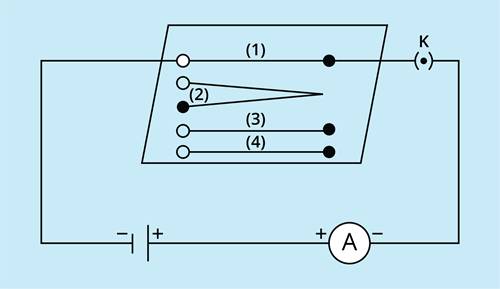PDF chapter test TRY NOW

Electric circuit to study the factors on which the resistance of conducting wires depends
- Complete an electric circuit consisting of a cell, an ammeter, a nichrome wire of length l [say, marked (1)] and a plug key, as shown in figure.
- Now, plug the key. Note the current in the ammeter.
- Replace the nichrome wire by another nichrome wire of same thickness but twice the length, that is 2l [marked (2) in the figure].
- Note the ammeter reading.
- Now replace the wire by a thicker nichrome wire, of the same length l [marked (3)]. A thicker wire has a larger cross-sectional area. Again note down the current through the circuit.
- Instead of taking a nichrome wire, connect a copper wire [marked (4) in figure] in the circuit. Let the wire be of the same length and same area of cross-section as that of the first nichrome wire [marked (1)]. Note the value of the current.
- Notice the difference in the current in all cases.
Does the current depend on the length of the conductor?
, the current value when the length of the wire is . The ammeter reading is when a thicker wire of the same length and material is used.
Does the current depend on the area of cross-section of the wire used?
, the ammeter reading when a wire of different materials with the same area of cross-section is used.
